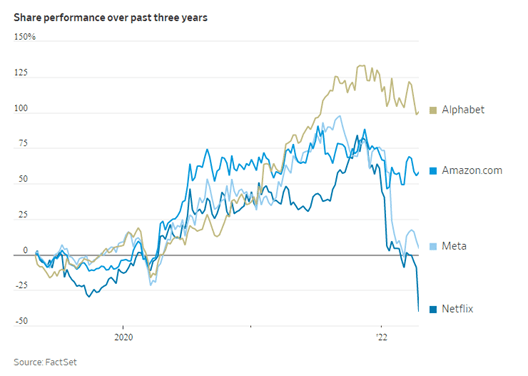The markets are abuzz this week with earnings reports. So far, we’ve gotten good news from Tesla and Procter & Gamble, bad news from Netflix and related streaming services. The rest fall somewhere in the middle – unless we’re looking at value stocks, which are generally having a better time of it these days, as investors look for safer, long-term bets.
Q1 earnings are rolling in…
The Netflix blow-up dragged shares of other streaming companies lower. Disney fell 5.6%, Roku lost 6.2% and Warner Bros. Discovery slid 6%. Paramount lost 8.6%…
All this has a lot of people asking why companies (and the markets) seem to be doing so well, when all we hear about is how challenging things are with the US and global economic recoveries. To this I respond with two bits of proven wisdom:
- First, and as you’ll often hear and read, the markets are not a direct reflection of the economy (although they do reflect investor sentiment, certainly). Well before the Federal Reserve began interest-rate hikes in March, companies had already started to increase prices for goods and services. That ups revenue before the full action/reaction cycle of inflation is even in place and for some, that provides fodder for better earnings reports.
- Second, and this is more important, the reports reflect past activity (and sentiment) and, as such, they’re only as a proxy for the future – and the world looks much different today than it did just a few months ago.
Early in Q1, we were grappling with the Omicron-variant surge, but also realizing that it wasn’t hospitalizing (or worse) the vast majority of people who caught it, which gave us some ease about the pandemic’s status. Inflation was emerging as a significant factor, too, but we were still feeling optimistic that it would be somewhat under control in the not-too-distant future. And, significantly, we had just finished celebrating holidays with friends and family for the first time in several long and challenging years and we were feeling great about it.
These got us off to a relatively positive start.
Fast forward to now and a tragic and terrifying cog has gotten into our wheel: It is, of course, Russia’s war against Ukraine. It’s a nightmare scenario on every level.
Existing home sales slip…sort of
The underlying problem is that there are still far fewer homes on the market than can meet demand, so the median sales price is still rising, even with mortgage rates increasing.
As I said in the last post, I don’t anticipate a reset here, just a bit of softening and mostly in secondary and tertiary markets – at least, I think that’ll be the case for a while.
So, if April’s feeling downright gloomy now, there are good reasons. And I still believe that a recession is highly likely, too.
Here, though, is where I find opportunities for optimism.
Ever the optimist
After a long, volatile, voluminous, outpriced and outsized run in all of the markets and asset classes, a recession is like a resting point, a reset – and now, the universal force that is the Federal Reserve is hoping to put things on pause for a bit. Not too much, that’s the hope, but just enough for us to get our collective bearings and begin to act in ways that make sense again.
Here’s what that could look like, in my opinion (and we’re seeing some signs already):
- We’ll see the major indices settle down a bit:
- Investors are (re)turning to value investing, because being defensive is about buying the best quality as an investor – and this is reflected in the relatively stable performance of the DJIA since Russia invaded Ukraine. Smart investors want stocks that represent goods and services with real and tangible value, price flexibility, good management and the capacity to innovate and pivot. (It’s “Warren Buffet 101” investing, so if you’re not familiar with how he’s amassed his billions yet (as well as billions for others), read up on his strategies.)
- Tech stocks, primarily those listed on NASDAQ, will settle down a bit. NASDAQ’s volatility so far this year is less related to geopolitical unrest than it is to consumer trends. The Netflix news, for example – including the loss of 200K subscribers, the potential addition of paid advertising and a crackdown on shared passwords – demonstrates the interconnectedness of all things based in tech.

One company’s extreme volatility can be balanced, though, by another’s good news: Shortly after Netflix bottomed out,
Tesla announced record quarterly profits of $3.3 billion, even as production is stymied by supply-chain challenges (Elon Musk predicts 60% production growth year-over-year from 2021 through 2022.)
- We’ll see competition in the housing market cool off a bit. Some potential buyers will simply back out as mortgage rates increase but others will finally be successful, albeit possibly not with the home or mortgage rate of their dreams but, rather, with something that they can use as a home, a solid investment asset, a bit of a hedge against inflation and, at the end of the day (aka, in a few years), something that they can leverage to truly get the home of their dreams.
- We’ll see employment opportunities stay strong and, unlike some past recessions that have resulted in high unemployment, I hope we’ll see a return to work for millions of Americans who bowed out, voluntarily or out of necessity, during the height of the pandemic.
- Although it seems contradictory on the surface, recessions can actually be great times to launch businesses and I hope a surge in innovation and a new wave of entrepreneurship is just around the corner.
- Along with this, recessions can be great times to invest – you just have to be cautious and patient: keep an eye out for storms and headwinds to maintain firm footing and, as always, go in knowing what you can lose, as well as potential rewards.
On the edge of great opportunities
To me, this is how it should be: When the wildness of the last several years is forced to slow down a bit, the dust settles and we can find ourselves on the precipice of fresh opportunities. Given all this, and in my opinion, the potential longer-term positive impacts of a mild recession – healthier markets and a stronger US economy – will outweigh the negatives we have to experience in the short term.
Today, and over the coming weeks and months, is the time to create and implement your long-term strategies for generational wealth and a healthy and prosperous future.









